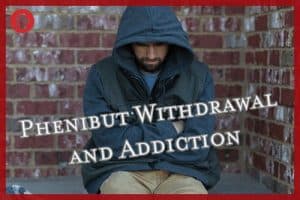Phenibut and the Potential for Withdrawal and Addiction
Phenibut (brand names include Citrocard, Fenibut, Noofen, and Phenybut) is a central nervous system depressant substance that is structurally related to the inhibitory neurotransmitter gamma-aminobutyric acid (GABA). Phenibut also has structural similarities to the drugs baclofen and pregabalin.
It was developed in the Soviet Union during the 1960s and has been used in Russia and Eastern European countries as a cognitive enhancer at very low doses and at moderate to higher doses to initiate sleep and relieve anxiety. The drug is not defined as a medication in other countries outside of Russia and Eastern European countries, but it is often sold on the Internet as a health aide or supplement to reduce anxiety, initiate sleep, and even as a cognitive enhancer. Phenibut is not currently regulated by the United States Drug Enforcement Administration.
Abuse of Phenibut
 Using phenibut at high doses is most often associated with recreational users. There appear to be no reliable figures on the number of individuals who use and abuse phenibut in the United States. It is easily available over the Internet.
Using phenibut at high doses is most often associated with recreational users. There appear to be no reliable figures on the number of individuals who use and abuse phenibut in the United States. It is easily available over the Internet.
Disadvantages appear to be its potential to result in extreme lethargy following use of the drug at even moderate doses, its potential for abuse, and its potential for the development of physical dependence. Tolerance to phenibut appears to develop rapidly based on the few case studies in the literature and on anecdotal reports online. Most of the information about the withdrawal symptoms associated with discontinuing phenibut comes from anecdotal reports on the Internet.
Its beneficial effects appear to be:
- To reduce anxiety or relieve stress
- To increase slow wave sleep
- To increase attention and concentration at low doses
Based on information from anecdotal reports and this case study, it can be hypothesized that the withdrawal process associated with discontinuing phenibut may have the following general timeline:
- A relatively quick onset may occur within 4-6 hours after discontinuation. Phenibut appears to have a half-life of about five hours.
- A varied symptom profile that can include numerous symptoms, some of which appear to be potentially dangerous.
- A relatively long course that can last 2-4 weeks.
- A relatively long course that can last 2-4 weeks.
According to the best available information, potential symptoms that can occur during the withdrawal process include:
- Anxiety, increased susceptibility to stress, shakiness, feelings of irritation, and agitation (likely rebound effects, which are effects that a particular substance controls that return once the substance is discontinued)
- Significant emotional and psychological symptoms, including issues with severe depression, depersonalization (feeling as if one is not real or as if one is detached from their body), visual hallucinations (probably extremely rare), and feelings of significant fear or dread but without any specific object or source in mind (may be related to rebound anxiety)
- Fatigue, appetite loss, and/or insomnia
- Muscle cramps, nausea, vomiting, and stomach cramps
- Irregular or increased heartbeat, increased blood pressure, and accompanying restlessness
- Sweating, mild fever, and/or chills
- Significant cravings
- Cognitive deficits that include problems with concentration and memory
- Tremors (rare)
Managing Withdrawal Symptoms
Baclofen was administered with a tapering dose of phenibut over the first nine weeks, and baclofen was then administered alone on a tapering schedule for an additional 12 weeks. This strategy was successful but complicated. Relatively high amounts of baclofen were required; the dosage suggested in the article is 10 mg of baclofen for every gram of phenibut that was normally used by the person. In addition, it should be noted that this individual had abused multiple drugs, including alcohol, benzodiazepines, and kratom, a stimulant drug of abuse, along with phenibut at the time of his treatment. He also had a complicated psychiatric history that appears to include significant issues with depression and anxiety.
A case study reported in 2012 in the Journal of Substance Abuse documented the case of an individual who was undergoing a withdrawal syndrome from phenibut and developed psychotic symptoms (hallucinations and delusions). The case study reported that it appeared that in this instance at least, withdrawal from phenibut was similar to the withdrawal syndrome that is associated with benzodiazepines and alcohol. Benzodiazepines were administered on a tapering schedule to assist this individual.
Because most of the information regarding withdrawal from phenibut is based on a very small number of case studies and anecdotal evidence from individuals who are self- reporting on the Internet, it is unclear at this time whether the withdrawal syndrome associated with phenibut might result in potentially fatal seizures. For this reason, anyone using phenibut should consult with a physician before they decide to lower the dose of the substance they are taking or wish to stop using the substance altogether. In addition, individuals seeking to reduce anxiety, initiate sleep, etc., would be advised not to use phenibut as a substance to assist them. Instead, consulting with a licensed mental health clinician, such as a psychiatrist or other physician, is more appropriate.
Signs of Abuse
There are few regulations applied to products that are not subject to scrutiny by the Food and Drug Administration (FDA), such as vitamin supplements, herbal remedies, etc. In addition, there are no controls over the amounts of the supplements that individuals can purchase.
Signs of abuse include:
- Withdrawal symptoms associated with the discontinuation of any nonregulated substance (a substance that is not prescribed by a physician and used under revision of a physician)
- Frequent cravings to use the substance
- Problems controlling use of the substance, such as:
- Using more of the substance than originally intended
- Often using the substance for longer periods than originally intended
- Spending significant time or resources to get the substance
- Using the substance to cope with everyday stressors
- Giving up important commitments or activities in order to continue using the substance
- Continuing to use the substance in spite of knowing that it is causing problems
- Significant development of tolerance, indicating that the person is using more and more of the substance and most likely using it at more frequent intervals
- Negative effects associated with using the substance that can include:
- Problems at work
- Problems in school
- Significant distress or dysfunction
- Problems with personal relationships
- Problems with physical or mental health
- Financial issues associated with trying to buy more of the substance
- Frequent daydreaming and romanticizing about substance use
Typically, a person displaying two or more of these above signs and symptoms would be suspected of having a substance use disorder. The formal diagnosis of any substance use disorder can only be made by a licensed mental health clinician. Likewise, the formal treatment of any substance use disorder should also only be undertaken by a licensed mental health clinician or a team of clinicians.
Even though the development of tolerance and withdrawal symptoms are associated with the diagnosis of a substance use disorder, simply undergoing the withdrawal process either by utilizing a cold-turkey approach or undergoing a professional physician-assisted withdrawal management program is not a sufficient program of recovery. Instead, individuals with substance use disorders need to become involved in long-term treatment programs once they complete the medical detox process. These programs should include some form of substance use disorder therapy (in groups or individual sessions), social support (preferably from family and friends), participation in peer support groups, medical management as needed, and other interventions as identified by an initial assessment performed by mental health clinicians.
Recovery from any substance use disorder requires years of involvement in treatment, years of established abstinence, support, and numerous ups and downs that may include problems with relapse, recovery, and recommitment. Individuals in treatment who view potential relapses as opportunities to learn, strengthen their program of recovery, and move forward are more likely to experience successful long-term recovery than individuals who view of relapse as a failure.
It’s never too late to reach out for help. If you or someone you love is struggling with the devastating side effects of addiction and are unsure of where to turn, call us today at . Oxford Treatment Center, American Addiction Centers’ Mississippi rehab, is ready to help you get the treatment you need today.
